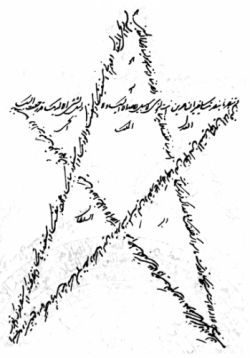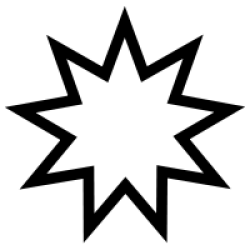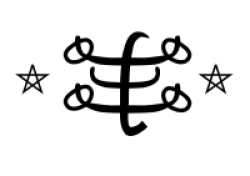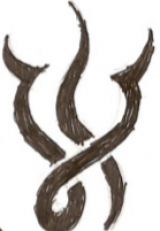Bahá'í symbols
This page lists of the various symbols in the Bahá'í symbols group.
The Bahá'í Faith (pron.: /bəˈhaɪ/) is a monotheistic religion emphasizing the spiritual unity of all humankind. Three core principles establish a basis for Bahá'í teachings and doctrine: the unity of God, that there is only one God who is the source of all creation; the unity of religion, that all major religions have the same spiritual source and come from the same God; and the unity of humankind, that all humans have been created equal, and that diversity of race and culture are seen as worthy of appreciation and acceptance. According to the Bahá'í teachings the human purpose is to learn to know and love God through such methods as prayer, reflection, and being of service to humankind.
The Bahá'í Faith was founded by Bahá'u'lláh in 19th-century Persia. Bahá'u'lláh was exiled for his teachings, from Persia to Ottoman Empire, and died while officially being a prisoner. After Bahá'u'lláh's death, under the leadership of his son, `Abdu'l-Bahá, the religion spread from its Persian and Ot
Symbols in this group:
Five-Pointed Star or Haykal
The five-pointed star, or haykal (Arabic: temple) is the symbol of the Bahá'í Faith as mentioned by Shoghi Effendi, the Guardian of the Bahá'í Faith: "Strictly speaking the 5-pointed star is the symbol of our Faith, as used by the Báb and explained by Him." The five-pointed star has been used as the outline of special letters or tablets by both the Báb and Bahá'u'lláh.
Nine-pointed star
According to the Abjad system of Isopsephy, the word Bahá' has a numerical equivalence of 9, and thus there is frequent use of the number 9 in Bahá'í symbols. The most commonly used symbol connected to the number 9 is the nine-pointed star; there is no particular design of the nine-pointed star that is used more often than others. While the star is not a part of the teachings of the Bahá'í Faith, it is commonly used as an emblem representing "9", because of the association of number 9 with perfection, unity and Bahá’.
Ringstone
The ringstone symbol was designed by `Abdu'l-Bahá, Bahá'u'lláh's son and successor, and as its name implies, is the most common symbol found on rings worn by Bahá'ís, but it is also used on necklaces, book covers, and paintings
Strength
The strength lies inside of this symbol. Taureans mostly have it in them. The strength inside of this artictectrialrayitik (ar-tik-tect-ree-ahL-ruh-yiht-ick-) has more that you can imagine.
Citation
Use the citation below to add this symbols group page to your bibliography:
Style:MLAChicagoAPA
"Bahá'í symbols." Symbols.com. STANDS4 LLC, 2025. Web. 22 Feb. 2025. <https://www.symbols.com/group/25/Bah%C3%A1%27%C3%AD+symbols>.










Have a discussion about the Bahá'í symbols group with the community:
Report Comment
We're doing our best to make sure our content is useful, accurate and safe.
If by any chance you spot an inappropriate comment while navigating through our website please use this form to let us know, and we'll take care of it shortly.
Attachment
You need to be logged in to favorite.
Log In